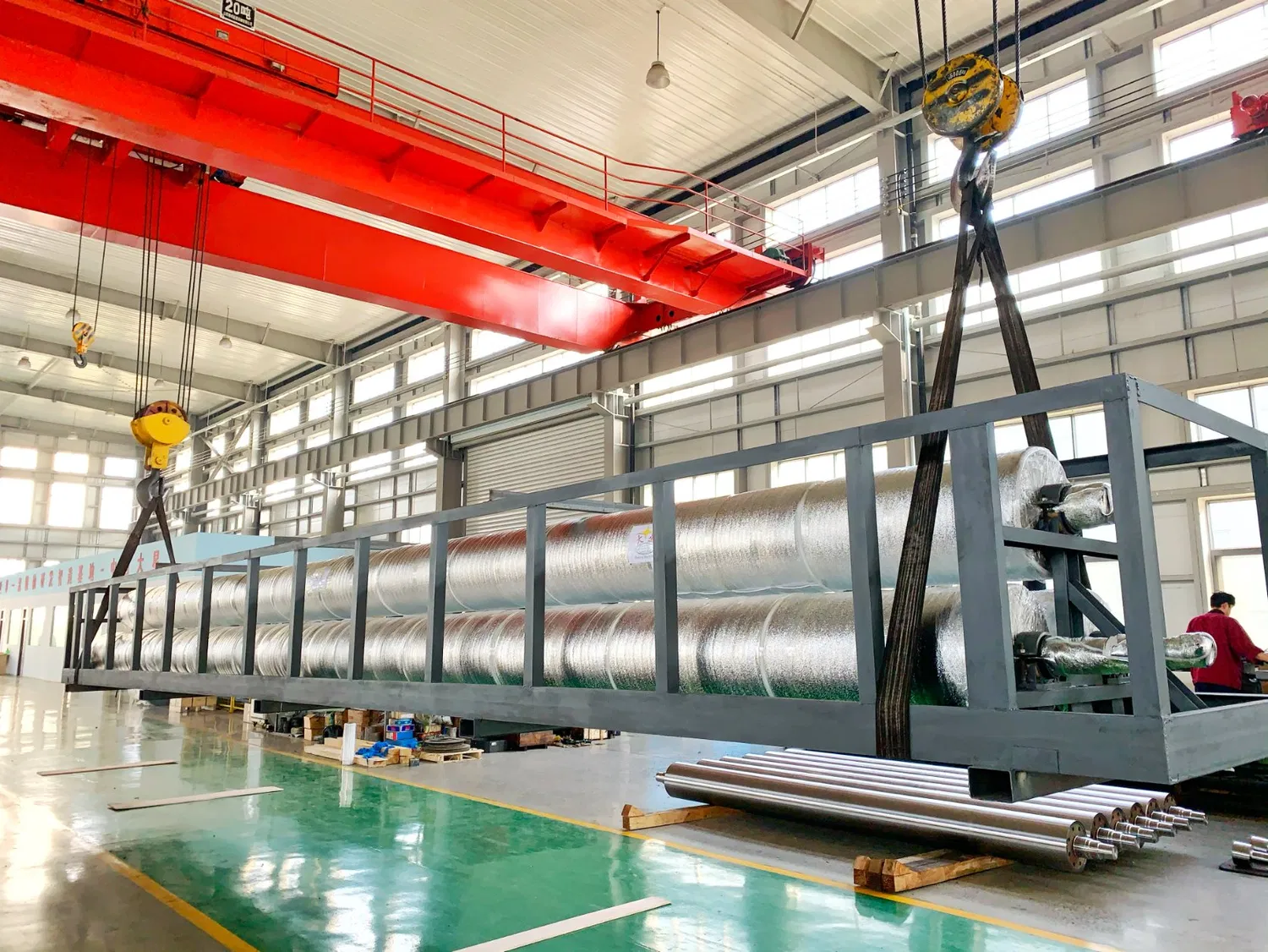In the demanding world of manufacturing processes that handle continuous webs of material, particularly within the paper industry, efficient liquid removal is not just a step – it's a critical operation that directly impacts product quality, energy consumption, and overall production speed. Mechanical dewatering, typically achieved through pressing, stands as the most energy-efficient way to remove water compared to thermal drying. For decades, engineers have sought innovative ways to maximize this efficiency while minimizing negative effects on the web. This pursuit has led to the development and refinement of various press roll designs, each with its own advantages and applications. Among these advancements, the **Blind Hole Press Roll** has emerged as a cornerstone technology, offering significant improvements in dewatering capability and operational stability, becoming an indispensable component in modern high-speed machinery. Understanding its design principles and benefits is key to optimizing many industrial processes.
The Engineering Behind Blind Hole Dewatering
So, what exactly is a **Blind Hole Press Roll** and why is it so effective? Unlike traditional plain rolls or even grooved rolls, a blind hole roll features a surface patterned with thousands, sometimes millions, of small, cylindrical depressions, known as blind holes. These holes do not go all the way through the roll shell but instead have a specific depth. As the web material (like a paper sheet) passes through the nip formed by the blind hole roll and an opposing roll (often a plain or suction roll), pressure is applied. This pressure forces water out of the web and into these precisely engineered blind holes. The holes act as temporary reservoirs, holding the expressed water, thereby preventing it from being reabsorbed into the web once the pressure is released or from being forced back into the sheet, which could cause crushing or damage, particularly at high speeds or with delicate materials. It's a remarkably simple concept, yet its execution requires high precision in manufacturing and design.
Designing for Maximum Water Removal Efficiency
The effectiveness of a blind hole press roll hinges critically on the design of these blind holes. Parameters such as the hole diameter, depth, pattern arrangement (layout on the roll surface), and the total percentage of the surface area covered by holes (often referred to as open area) are meticulously calculated based on the specific application. For instance, denser, smaller patterns might be suitable for certain paper grades, while larger, deeper holes could be necessary for higher speeds or materials with different dewatering characteristics. The pattern can be straight, spiral, or more complex, influencing how water flows within the holes and exits the nip. Interestingly enough, the interaction between the blind holes and the press felt (a specialized fabric used in papermaking presses to support the web and transport water) is also vital. The felt's structure must allow water to readily transfer into the holes. Optimized **blind drilling patterns** are the result of extensive research and practical experience, tailored to achieve the best possible water removal without compromising the integrity of the web or the felt, showcasing the intricate engineering involved.
Key Advantages in Manufacturing Processes
The adoption of **Blind Hole Press Rolls** has brought about significant operational benefits across industries. One of the most compelling advantages is enhanced dewatering efficiency. By providing dedicated space for water squeezed from the web under pressure, blind holes allow for more water to be removed mechanically in the press section. This is tremendously important because removing water mechanically requires far less energy than removing it through evaporation in the drying section. Consequently, manufacturers can achieve substantial energy savings, leading to lower operating costs and a smaller environmental footprint. Furthermore, more consistent and efficient dewatering results in a dryer web entering the dryer section, which can potentially allow for increased machine speeds and higher production output. Frankly speaking, the impact on the bottom line and sustainability goals is considerable.
Improving Product Quality and Operational Stability
Beyond just energy savings and speed, blind hole rolls also contribute significantly to improving the quality of the final product and enhancing operational stability. By effectively managing the water flow within the press nip, these rolls help prevent issues like crushing, where excessive hydraulic pressure damages the web structure, or shadow marking, where patterns from underlying structures appear on the final product. This is particularly crucial for producing high-quality paper grades or delicate non-woven materials. Additionally, more uniform dewatering across the width of the web leads to a more consistent moisture profile, which is vital for downstream processes and final product characteristics. In my experience, a consistently dry and uniform web is less prone to breaks, leading to smoother operations, reduced downtime, and improved overall equipment effectiveness. This focus on reliable **paper machine dewatering technology** is paramount for manufacturers striving for excellence.
Applications Beyond Papermaking
While most commonly associated with the paper industry, the principle and benefits of mechanical dewatering using patterned rolls extend to other manufacturing sectors as well. Any process involving the formation or treatment of a continuous web or sheet where significant liquid needs to be removed can potentially benefit from blind hole or similar patterned roll technology. This includes the production of textiles, non-woven fabrics, felt, and even certain types of board or composites. The core challenge remains the same: remove as much liquid as possible mechanically and uniformly without damaging the material. The specific design of the blind holes – their size, depth, and pattern – would be adapted to the unique properties of the material being processed and the desired level of dryness. It's worth noting that the foundational concept is highly transferable, making patterned dewatering rolls a versatile tool in industrial processing.
Maintaining the Performance of Blind Hole Press Rolls
To ensure that a blind hole press roll continues to deliver optimal performance over its lifespan, regular and proper maintenance is essential. Given the nature of the materials being processed and the liquids being removed, the blind holes can, over time, become clogged with fibers, fillers, pitch, or other process contaminants. Clogging reduces the volume available in the holes, diminishing dewatering efficiency and potentially leading to uneven pressing and quality issues. The roll surface itself is also subject to wear from the abrasive action of the web and the felt. Therefore, routine inspection, cleaning, and resurfacing are critical maintenance activities. Cleaning methods can range from high-pressure water showers applied during operation to more intensive off-line chemical or mechanical cleaning procedures. Monitoring roll surface condition and blind hole cleanliness allows manufacturers to proactively address potential problems before they impact production and product quality.
Addressing Challenges Through Expert Solutions
Despite diligent maintenance, blind hole press rolls face inherent challenges, primarily related to keeping the holes clean and the roll surface in optimal condition. Persistent clogging in challenging process environments can be a major headache, directly reducing dewatering efficiency and increasing the load on the dryer section. Surface wear, if left unchecked, can alter the roll profile and affect pressing uniformity. This is where specialized expertise and tailored solutions become invaluable. High-quality materials for roll construction, advanced cleaning technologies, and precision resurfacing techniques are key to mitigating these issues. Many experts agree that partnering with suppliers who understand the nuances of **press roll design** and maintenance can significantly extend the operational life of these critical components and maintain peak performance. Identifying the specific contaminants and wear patterns in your process is the first step toward finding the right solution.
The Evolving Landscape of Press Roll Technology
The field of industrial rolls, including blind hole designs, isn't static. Driven by the continuous push for higher speeds, greater efficiency, and improved product quality, research and development continue. Advancements are being made in materials science, leading to more durable and less-prone-to-clogging roll shell materials or coatings. Drilling technology is also evolving, allowing for more complex and potentially more efficient blind hole patterns. Furthermore, integrating sensor technology to monitor roll surface temperature, vibration, or even hole cleanliness in real-time is becoming increasingly feasible. These innovations promise to further enhance the performance, reliability, and intelligence of press rolls. Have you ever wondered what the "smart" press roll of the future might look like, autonomously detecting and addressing issues?
Selecting the Ideal Blind Hole Press Roll
Choosing the correct blind hole press roll for a specific application is a crucial decision that requires careful consideration of various factors. It's not simply about replacing an old roll; it's about selecting a roll optimized for your machine speed, the characteristics of the material you are processing, the desired dryness level, and the overall machine configuration (e.g., the type of opposing roll and press felt used). The operational environment, including temperature, chemicals present, and potential contaminants, also plays a role in selecting appropriate materials and coatings. A correctly specified roll will maximize dewatering efficiency, minimize operational problems like crushing or felt wear, and contribute to energy savings and product quality. Conversely, a poorly chosen roll can hinder performance and even cause damage. Consulting with specialists who possess deep knowledge of press section dynamics and roll design is highly recommended to ensure you make the best choice for your specific needs.
Partnering for Enhanced Dewatering Performance
Ultimately, the **Blind Hole Press Roll** remains a vital piece of engineering for efficient mechanical dewatering in numerous industrial processes. Its ability to significantly improve dryness, save energy, and enhance product quality makes it indispensable in modern production lines. While challenges like clogging and wear exist, they are manageable with the right maintenance strategies and technological solutions. Achieving peak performance with these rolls requires understanding their design principles, recognizing their benefits, and implementing effective maintenance practices. To be honest, optimizing press section performance is a continuous effort, and having the right partners can make all the difference. If you're looking to enhance your dewatering efficiency, reduce energy costs, and improve your final product quality by leveraging advanced press roll technology, the next step is to connect with experts who can assess your specific needs and recommend tailored solutions, from roll design to maintenance strategies.
For more detailed information, please visit our official website: Blind Hole Press Roll



